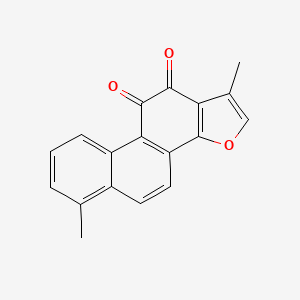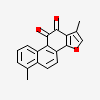Tanshinone I
- Tanshinone I
- 568-73-0
- Tanshinone A
- Tanshinon I
- Tanshinone
- Create:2005-03-27
- Modify:2025-01-18

- tanshinone
- tanshinone I
- tanshinone II A
- tanshinone II B
- tanshinone IIA
- tanshinone IIB
- TTE-50
- Tanshinone I
- 568-73-0
- Tanshinone A
- Tanshinon I
- Tanshinone
- 1,6-Dimethylphenanthro[1,2-b]furan-10,11-dione
- Tanshinone-I
- UNII-03UUH3J385
- 03UUH3J385
- 1,6-dimethylnaphtho[1,2-g][1]benzofuran-10,11-dione
- MFCD00210563
- 1,6-Dimethyl-phenanthro[1,2-b]furan-10,11-dione
- Phenanthro[1,2-b]furan-10,11-dione, 1,6-dimethyl-
- MLS000697676
- 1,6-Dimethylphenanthro(1,2-b)furan-10,11-dione
- Phenanthro(1,2-b)furan-10,11-dione, 1,6-Dimethyl-
- SMR000445578
- 1,6-DIMETHYL-PHENANTHRO(1,2-B)FURAN-10,11-DIONE
- TanshinoneI
- Tanshinquinone I
- C18H12O3
- Tanshinone I?
- Tanshinone I,(S)
- Tanshinone I (Standard)
- MLS006011773
- SCHEMBL244391
- 1,6-dimethylnaphtho[1,2-g]benzofuran-10,11-dione
- CHEMBL363535
- cid_114917
- AIGAZQPHXLWMOJ-UHFFFAOYSA-
- BDBM51317
- HY-N0134R
- DTXSID90972247
- Tanshinone I, analytical standard
- CHEBI:149906
- HMS2222J14
- HMS3656A11
- Tanshinone I, >=98% (HPLC)
- BCP28292
- HY-N0134
- BBL010133
- s2364
- STK801472
- AKOS005613012
- AC-7999
- CCG-267206
- NCGC00247624-01
- NCGC00247624-02
- NCGC00247624-03
- NCGC00247624-05
- AS-68049
- DB-052982
- SW219821-1
- Tanshinon I, Tanshinone A, Tanshinquinone I
- Q-100655
- TANSHINONE I (CONSTITUENT OF CHINESE SALVIA)
- 1,6-dimethylnaphtho[1,2-g]benzofuran-10,11-quinone
- 1,6-Dimethylphenanthro[1,2-b]furan-10,11-dione #
- BRD-K34073885-001-07-7
- BRD-K34073885-001-09-3
- Q27247588
- TANSHINONE I (CONSTITUENT OF CHINESE SALVIA) [DSC]
- 1,6-dimethyl-10H,11H-phenanthro[1,2-b]furan-10,11-dione
- 54693-68-4
- InChI=1/C18H12O3/c1-9-4-3-5-12-11(9)6-7-13-15(12)17(20)16(19)14-10(2)8-21-18(13)14/h3-8H,1-2H3
- Phenanthro[1,2-b]furan-10,11-dione, 1,6-dimethyl-; 1,6-Dimethylphenanthro[1,2-b]furan-10,11-dione; Tanshinon I; Tanshinone A; Tanshinone I
249 100
231 11
221 3
455 100
249 100
337 100
Not Classified
Reported as not meeting GHS hazard criteria by 38 of 39 companies (only 2.6% companies provided GHS information). For more detailed information, please visit ECHA C&L website.
Aggregated GHS information provided per 39 reports by companies from 2 notifications to the ECHA C&L Inventory.
Reported as not meeting GHS hazard criteria per 38 of 39 reports by companies. For more detailed information, please visit ECHA C&L website.
There is 1 notification provided by 1 of 39 reports by companies with hazard statement code(s).
Information may vary between notifications depending on impurities, additives, and other factors. The percentage value in parenthesis indicates the notified classification ratio from companies that provide hazard codes. Only hazard codes with percentage values above 10% are shown.
Patents are available for this chemical structure:
https://patentscope.wipo.int/search/en/result.jsf?inchikey=AIGAZQPHXLWMOJ-UHFFFAOYSA-N
- BindingDBLICENSEAll data curated by BindingDB staff are provided under the Creative Commons Attribution 3.0 License (https://creativecommons.org/licenses/by/3.0/us/).https://www.bindingdb.org/rwd/bind/info.jsp1,6-dimethylnaphtho[1,2-g][1]benzofuran-10,11-dionehttps://www.bindingdb.org/rwd/bind/chemsearch/marvin/MolStructure.jsp?monomerid=51317
- CAS Common ChemistryLICENSEThe data from CAS Common Chemistry is provided under a CC-BY-NC 4.0 license, unless otherwise stated.https://creativecommons.org/licenses/by-nc/4.0/
- ChemIDplusChemIDplus Chemical Information Classificationhttps://pubchem.ncbi.nlm.nih.gov/source/ChemIDplus
- DrugBankLICENSECreative Common's Attribution-NonCommercial 4.0 International License (http://creativecommons.org/licenses/by-nc/4.0/legalcode)https://www.drugbank.ca/legal/terms_of_useTanshinone Ihttps://www.drugbank.ca/drugs/DB16886
- EPA DSSTox1,6-Dimethylphenanthro[1,2-b]furan-10,11-dionehttps://comptox.epa.gov/dashboard/DTXSID90972247CompTox Chemicals Dashboard Chemical Listshttps://comptox.epa.gov/dashboard/chemical-lists/
- European Chemicals Agency (ECHA)LICENSEUse of the information, documents and data from the ECHA website is subject to the terms and conditions of this Legal Notice, and subject to other binding limitations provided for under applicable law, the information, documents and data made available on the ECHA website may be reproduced, distributed and/or used, totally or in part, for non-commercial purposes provided that ECHA is acknowledged as the source: "Source: European Chemicals Agency, http://echa.europa.eu/". Such acknowledgement must be included in each copy of the material. ECHA permits and encourages organisations and individuals to create links to the ECHA website under the following cumulative conditions: Links can only be made to webpages that provide a link to the Legal Notice page.https://echa.europa.eu/web/guest/legal-notice1,6-Dimethylphenanthro[1,2-b]furan-10,11-dionehttps://echa.europa.eu/substance-information/-/substanceinfo/100.211.0031,6-Dimethylphenanthro[1,2-b]furan-10,11-dione (EC: 685-417-1)https://echa.europa.eu/information-on-chemicals/cl-inventory-database/-/discli/details/216040
- FDA Global Substance Registration System (GSRS)LICENSEUnless otherwise noted, the contents of the FDA website (www.fda.gov), both text and graphics, are not copyrighted. They are in the public domain and may be republished, reprinted and otherwise used freely by anyone without the need to obtain permission from FDA. Credit to the U.S. Food and Drug Administration as the source is appreciated but not required.https://www.fda.gov/about-fda/about-website/website-policies#linking
- ChEBI
- LOTUS - the natural products occurrence databaseLICENSEThe code for LOTUS is released under the GNU General Public License v3.0.https://lotus.nprod.net/Tanshinone Ihttps://www.wikidata.org/wiki/Q27247588LOTUS Treehttps://lotus.naturalproducts.net/
- ChEMBLLICENSEAccess to the web interface of ChEMBL is made under the EBI's Terms of Use (http://www.ebi.ac.uk/Information/termsofuse.html). The ChEMBL data is made available on a Creative Commons Attribution-Share Alike 3.0 Unported License (http://creativecommons.org/licenses/by-sa/3.0/).http://www.ebi.ac.uk/Information/termsofuse.htmlChEMBL Protein Target Treehttps://www.ebi.ac.uk/chembl/g/#browse/targets
- ClinicalTrials.govLICENSEThe ClinicalTrials.gov data carry an international copyright outside the United States and its Territories or Possessions. Some ClinicalTrials.gov data may be subject to the copyright of third parties; you should consult these entities for any additional terms of use.https://clinicaltrials.gov/ct2/about-site/terms-conditions#Use
- Crystallography Open Database (COD)LICENSEAll data in the COD and the database itself are dedicated to the public domain and licensed under the CC0 License. Users of the data should acknowledge the original authors of the structural data.https://creativecommons.org/publicdomain/zero/1.0/
- The Cambridge Structural Database
- Human Metabolome Database (HMDB)LICENSEHMDB is offered to the public as a freely available resource. Use and re-distribution of the data, in whole or in part, for commercial purposes requires explicit permission of the authors and explicit acknowledgment of the source material (HMDB) and the original publication (see the HMDB citing page). We ask that users who download significant portions of the database cite the HMDB paper in any resulting publications.http://www.hmdb.ca/citingTanshinone Ihttp://www.hmdb.ca/metabolites/HMDB0258714
- Japan Chemical Substance Dictionary (Nikkaji)
- KNApSAcK Species-Metabolite Database
- Natural Product Activity and Species Source (NPASS)
- MassBank of North America (MoNA)LICENSEThe content of the MoNA database is licensed under CC BY 4.0.https://mona.fiehnlab.ucdavis.edu/documentation/license
- Metabolomics Workbench
- NIST Mass Spectrometry Data CenterLICENSEData covered by the Standard Reference Data Act of 1968 as amended.https://www.nist.gov/srd/public-lawPhenanthro[1,2-b]furan-10,11-dione, 1,6-dimethyl-http://www.nist.gov/srd/nist1a.cfm
- SpectraBasePhenanthro[1,2-b]furan-10,11-dione, 1,6-dimethyl-https://spectrabase.com/spectrum/DRDM3ZbdsfsPhenanthro[1,2-b]furan-10,11-dione, 1,6-dimethyl-https://spectrabase.com/spectrum/43Q7sDXmMUfTANSHINONE Ihttps://spectrabase.com/spectrum/7mnyaShGWEaTANSHINONE_Ihttps://spectrabase.com/spectrum/KxLSQGdIajHphenanthro[1,2-b]furan-10,11-dione, 1,6-dimethyl-https://spectrabase.com/spectrum/I9jjQsRZK7c
- NMRShiftDB
- Springer Nature
- SpringerMaterials
- Thieme ChemistryLICENSEThe Thieme Chemistry contribution within PubChem is provided under a CC-BY-NC-ND 4.0 license, unless otherwise stated.https://creativecommons.org/licenses/by-nc-nd/4.0/
- Wikidatatanshinone Ihttps://www.wikidata.org/wiki/Q27247588
- PubChem
- Medical Subject Headings (MeSH)LICENSEWorks produced by the U.S. government are not subject to copyright protection in the United States. Any such works found on National Library of Medicine (NLM) Web sites may be freely used or reproduced without permission in the U.S.https://www.nlm.nih.gov/copyright.htmlAnti-Inflammatory Agents, Non-Steroidalhttps://www.ncbi.nlm.nih.gov/mesh/68000894Immunosuppressive Agentshttps://www.ncbi.nlm.nih.gov/mesh/68007166Anti-Infective Agentshttps://www.ncbi.nlm.nih.gov/mesh/68000890Anticoagulantshttps://www.ncbi.nlm.nih.gov/mesh/68000925Antineoplastic Agents, Phytogenichttps://www.ncbi.nlm.nih.gov/mesh/68000972
- GHS Classification (UNECE)GHS Classification Treehttp://www.unece.org/trans/danger/publi/ghs/ghs_welcome_e.html
- MolGenieMolGenie Organic Chemistry Ontologyhttps://github.com/MolGenie/ontology/
- PATENTSCOPE (WIPO)SID 403575005https://pubchem.ncbi.nlm.nih.gov/substance/403575005



